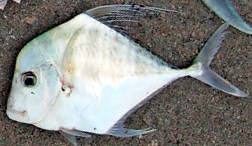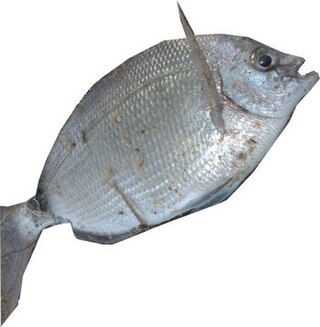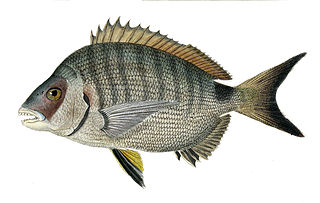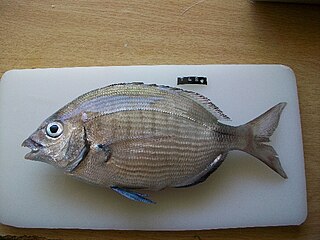
The Indian threadfish, also known as the Indian threadfin, diamond trevally, mirror fish or plumed trevally, is a large species of coastal marine fish of the jack family, Carangidae. The species is widespread in the waters of the tropical Indo-West Pacific Ocean, ranging from east Africa to India, Asia, Indonesia and Australia. Adult fish tend to inhabit coastal waters over reefs down to 100 m in depth, while juveniles inhabit a variety of environments including estuaries and seagrass beds. The Indian threadfish is similar to the other two species in the genus Alectis, with a slight concavity in the profile of the head the most obvious distinguishing feature. It is a large species, growing to 165 cm and 25 kg in weight. The species is carnivorous, consuming fishes, cephalopods and crustaceans. The Indian threadfish is of minor commercial importance, and has been the subject of aquaculture in Singapore.

Acanthopagrus australis, the yellowfin bream, also known as sea bream, surf bream, silver bream or eastern black bream, is a species of marine and freshwater fish of the porgy family, Sparidae. It is a deep-bodied fish, occasionally confused with Acanthopagrus butcheri, but is generally distinguished by its yellowish ventral and anal fins. It is a popular target for recreational fishermen due to its capacity to fight well above its weight coupled with its table quality.

The spottail pinfish is an ocean-going species of fish in the family Sparidae. It is also known as the spottail seabream or spottail pinkish porgy. Along with other members of their family, Spottail pinfish are occasionally eaten and considered by some to be a panfish.

Diplodus sargus, the white seabream or sargo is a species of marine ray-finned fish belonging to the family Sparidae, which includes the seabreams and porgies. This fish is found in the eastern Atlantic Ocean and in the Mediterranean Sea. It is a target species for commercial fisheries and is grown in aquaculture. D. sargussensu lato was formerly thought to be a widespread species in the eastern Atlantic and western Indian Oceans but the taxa outside of D, sargussensu stricto are now recognised as valid species and are part of the D. sargus species complex.

Chrysoblephus gibbiceps, the red stumpnose, red stumpnose seabream or Miss Lucy, is a species of marine ray-finned fish belonging to the family Sparidae, the seabreams and porgies. This fish is endemic to the southwestern Indian Ocean off the coast of South Africa. The International Union for Conservation of Nature classifies this species as Endangered.

Diplodus is a genus of marine ray-finned fish belonging the family Sparidae, which includes the seabreams and porgies. These fishes are found in the Atlantic Ocean, the Mediterranean Sea and the western Indian Ocean.

Diplodus vulgaris, the common two-banded sea bream, is a species of marine ray-finned fish belonging to the family Sparidae, which includes the seabreams and porgies. This species is found in the northeastern Atlantic Ocean and the Mediterranean. It is an important species for fisheries and is grown in aquaculture.

Rhabdosargus sarba, also known as the goldlined seabream, silver bream, tarwhine, or yellowfin bream, is a species of marine ray-finned fish belonging to the family Sparidae, which includes the seabreams and porgies. This fish has a wide [[Indo-Pacific distribution.

Rhabdosargus is a genus of ray-finned fish belonging to the family Sparidae, which includes the seabreams and porgies. These fishes are found in the southeastern Atlantic Ocean and throughout the Indo-West Pacific, although mainly in the western Indian Ocean.

Acanthopagrus berda, the goldsilk seabream, sly bream, picnic seabream, black sea bream, black porgy, picky bream, silver bream or river bream, is a species of ray-finned fish belonging to the family Sparidae, the sea breams and porgies. This species is found in the Indian Ocean.

Cheimerius is a monospecific genus of marine ray-finned fish belonging to the family Sparidae, the seabreams and porgies. The only species in the genus is Cheimerius nufar, the santer seabream, santer or soldier, of the Indian Ocean.

Crenidens is a small genus of three species of seabream from the family Sparidae from the western Indian Ocean. It was previously regarded as monotypic, with the sole species being the Karenteen sea bream Crenidens crenidens but two other species are now accepted as valid species, separate from the type species, C. crenidens.

The St. Helena white seabream is a species of marine ray-finned fish belonging to the family Sparidae, which includes the seabreams and porgies. This fish is endemic to the island of Saint Helena in the southern Atlantic.

The Tstsikamma Marine Protected Area is a marine protected area on the south coast of South Africa, in both the Western Cape and Eastern Cape. It is on the coast of the Tsitsikamma National Park, and is one of the oldest MPAs in the country. The MPA provides protection for marine habitat and wildlife, including birds and threatened and endangered fish species.

Diplodus hottentotus, the zebra, is a species of marine ray-finned fish belonging to the family Sparidae, which includes the seabreams and porgies. This fish is found in the Western Indian Ocean off Southern Africa.

Diplodus capensis, the Cape white seabream or blacktail seabream, is a species of marine ray-finned fish belonging to the family Sparidae, which includes the seabreams and porgies. This fish is found around the coasts of Southern Africa.

Diplodus annularis, the annular seabream is a species of marine ray-finned fish belonging to the family Sparidae, the family which includes the seabreams and porgies. This species is found in the Eastern Atlantic Ocean and Mediterranean.

Rhabdosargus globiceps, the white stumpnose or go-home fish, is a species of marine ray-finned fish belonging to the family Sparidae, which includes the seabreams and porgies. This fish is endemic to the waters off Southern Africa.

Rhabdosargus haffara, the haffara seabream or Haffara stumpnose, is a species of marine ray-finned fish belonging to the family Sparidae, which includes the seabreams and porgies. This fish is found in the northwestern Indian Ocean.
Rhabdosargus niger, the blackish stumpnose, is a species of marine ray-finned fish belonging to the family Sparidae, which includes the seabreams and porgies. This fish is known only from the western coast of Kalimantan in Indonesia.



















